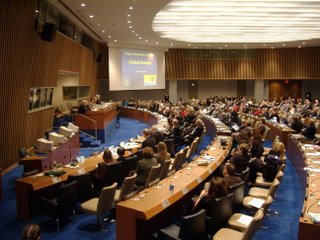The "Wise Choice" For The Civic-Minded Business Owner, Executive, and Professional
 Established in 1909, the Rotary Club of New York is an organized and enjoyable way for civic-minded executives and professionals to contribute their skills to the progress of New York and to the needy areas of the world. As a Rotarian, you and your company will become part of the 1.2 million worldwide Rotarian network, and warmly welcomed at the 33,000 clubs in more that 172 countries. You will also establish life- long friendships with other like-minded men and women in a cross-section of industries and professions. (Photo taken from the German Mission to the United Nations' Cafe where we host a monthly breakfast Round-Table discussion to enhance the Rotary/ UN partnership.)
Established in 1909, the Rotary Club of New York is an organized and enjoyable way for civic-minded executives and professionals to contribute their skills to the progress of New York and to the needy areas of the world. As a Rotarian, you and your company will become part of the 1.2 million worldwide Rotarian network, and warmly welcomed at the 33,000 clubs in more that 172 countries. You will also establish life- long friendships with other like-minded men and women in a cross-section of industries and professions. (Photo taken from the German Mission to the United Nations' Cafe where we host a monthly breakfast Round-Table discussion to enhance the Rotary/ UN partnership.)Be a Part of the Rotary Club of New York and Help Make a Difference!
In 1945 our club created its own, IRS recognized, Foundation of the Rotary Club of New York. As a result, in concert with a number of interesting and enjoyable fund raisers, our club is proud to have provided support to needy local and international projects -The Heart and Soul of our Club - for nearly 100 years.
Part of our club's service projects include providing technical and financial assistance, as well as providing helping-hands and recognition to a number of worthy New York organizations:
They include
- An Upper Manhattan Soup Kitchen
- After-School Computer Center
- Monthly Round-Table Breakfast Meeting at the United Nations with UN officials and ambassadors to assist in the Millennium Development Goals http://nyrotaryunitednations.blospot.com/
- Policeman Recognition Day
- Fireman Recognition Day
- Monthly Public High School Scholarships
- City-wide Essay Contest Scholarship
- Financing, hosting and arranging high-risk surgery at a New York Hospital for children from countries where the surgical procedure is not available. www.giftoflifeinternational.org
How to Apply for Membership?
We encourage all civic-minded business owners, managers, and professionals to explore the benefits of Rotary membership. If you and/or your company would like more information about becoming a part of the legendary Rotary Club of New York, or would like to visit one of our regular lunches, contact our Executive Director at ny.rotary@verizon.org , or one of our membership co-chairpersons: Lou Dipaolo at louis.dipaolo@verizon.net or Tom McConnon at Thomasref@aol.com
Guest Speaker Program
At nearly every weekly meeting, we invite an informative and recognized industry leader to meet with club members. They provide us with first-hand insight on a wide-array of relevent topics such as politics, economics, finance, poverty-eradication, health, media, art, music, history, film, etc. The presentation and Q&A period normally lasts about 30 minutes, but our guest(s) usually remain after the lunch for an informal, extended conversation.
Where We Meet
One of the wise policies of the The Rotary Club of New York, as with most Rotary Clubs, is not to own any real estate for our weekly meetings. Rotarians prefer to spend their time and energy on service projects and fellowship with other like-minded individuals, rather than expending resources on the costly responsibility of maintaining and managing a building. It is the tradition of Rotarians to simply meet at a comfortable and convenient restaurant to enjoy our weekly meetings. Since December 2007, we meet every Monday at the Harvard Club at 35 w. 44th St., from 12:15pm to 1:30pm. where we have been very comfortable for the last five years. We normally meet on the third floor banquet room, but ask the doorman for our exact location for that week. The cost of the lunch is $50.00. Reservations can be made by contacting the Executive Director or a membership chairperson.
Rotary's Polio-Plus Program that was started in 1985 is credited with the near-eradication of polio from our planet. We are very proud of the recent Wall Street Journal Editorial. The NY Times had a similar editorial but did not recommend us for the "Noble Peace Prize".
WSJ Editorial April 12, 2005
"Today marks the 50th anniversary for the Salk polio vaccine. Poliomyelitis, also know as infantile paralysis, used to be one of childhood’s most feared diseases. A few years after Dr. Jonas Salk announced his vaccine on April 12, 1955, nearly every child in the U.S. was protected. Today polio has disappeared from the Americas, Europe and the Western Pacific and is nearly gone from the rest of the world. A too-little known part of this feat is the role played by Rotary, the international businessman’s club, which in 20 years adopted the goal of wiping out the disease. Rotary understood that medical breakthroughs are worthless unless people aren’t afraid to immunize their children and efficient delivery systems exist to get the vaccine to them. And so it mobilized its members in 30,100 clubs in 166 countries to make it happen. In 1985, when Rotary launched its eradication program, there were an estimated 350,000 new cases of polio in 125 countries. Last Year, 1,263 cases were reported. More than one million Rotary members have volunteered their time or donated money to immunize two billion children in 122 countries. In 1988, Rotary money and its example were the catalyst for a global eradication drive joined by the World Health Organization, Unicef and the U.S. Centers for Disease Control. In 2000 Rotary teamed up with the United Nations Foundation to raise $100 million in private money for the program. By the time the world is certified as polio-free probably in 2008-Rotary will have contributed $600 million to its eradication effort. An economist of our acquaintance calls Rotary’s effort the most successful private health-care initiative ever. A vaccine-company CEO recently volunteered to us that the work of Rotary and the Gates Foundation, both private groups, has been more effective than any government in promoting vaccines to save lives. It’s become fashionable in some quarters to deride civic volunteerism, but Rotary’s unsung polio effort deserves the Nobel Peace Prize. "
It should be noted that our Polio-Plus program is only the tip of the iceberg. Tens of thousands of Club to Club poverty-eradication projects are completed every year. Most of these projects are not regestered with any central agency or even with Rotary International. Therefore, there is no centralized annual accounting of these projects, but it is in the tens, if not hundreds of millions of dollars. Visit any developing country and it would be very difficult to find a region where a Rotary Club from an economically developed country has not built a school house, medical clinic, or ball field.
YIR, tm



